A
B
C
D
E
F
G
H
I
J
K
L
M
N
O
P
Q
R
S
T
U
V
W
X
Y
Z
Click a letter to see a list of conditions beginning with that letter.
Click 'Topic Index' to return to the index for the current topic.
Click 'Library Index' to return to the listing of all topics.
Pulmonary Function Tests
Pulmonary function tests (also called lung function tests) help measure how well your lungs work. The tests measure the amount of air you breathe out (exhale) and how long it takes for you to exhale completely. These tests are done to diagnose lung conditions, such as asthma and chronic obstructive pulmonary disease (COPD). They may be done before and after you take certain medicines. They may also be used to determine if your shortness of breath gets worse with exercise. Over time, pulmonary function tests can help you and your healthcare providers see how well your treatment is working. Age, sex, ethnicity, and height are all used to determine normal test result values.
 |
| Spirometry measures how much air you can take into your lungs and how fast you can blow the air out. |
Your experience
A complete pulmonary function test has 3 parts. You may be given the full test or only certain parts. The full test is painless. It can last 45 to 90 minutes. If you get tired, you can take a break between parts of the test.
Before your test
Follow any instructions you are given to get ready for the test. Otherwise, your test may be canceled.
-
Stop smoking for at least 1 hour before the test, or as directed.
-
Don't drink alcohol for at least 4 hours before the test.
-
Ask your healthcare provider if you should stop taking certain medicines, including breathing medicines, 4 to 24 hours before the test.
-
Don't have caffeine and eat only a light meal. Don't eat a large meal less than 2 hours before the test. Also, limit the amount of fluids you drink.
-
Don't exercise heavily for 30 minutes before the test.
-
Wear loose clothes that don’t restrict your breathing.
Tell the healthcare provider if you have any of these symptoms during the test:
During your test
The healthcare provider will coach you during your test. Depending on how many parts of the test you have, you may sit in a chair and breathe through a mouthpiece. Or you may sit in a clear plastic box that looks like a phone booth. You will wear nose clips so you only breathe through your mouth. The 3 parts of the test are:
-
Spirometry. You will hold your breath and blow it out fast. Spirometry is repeated at least 3 times to measure your best effort.
-
Diffusion. You will hold your breath for 10 seconds. The test measures how well your lungs move air into your blood.
-
Lung volume. You will breathe in different mixtures of air. How much air you breathe in and out is measured. The amount of air that stays in your lungs is also measured.
After your test
After the test, you can go back to your normal diet, activity, and medicines, unless your healthcare provider tells you otherwise. If you were asked to skip medicines before the test, ask your provider if you should take them now. Your provider will talk about the test results. Ask if you will receive information over the phone or at your next visit.
Airflow measures
Pulmonary function tests measure how much air you can exhale, and how quickly. There are several types of pulmonary function graphs that show data from the tests. Some of the things that tests measure include:
-
Tidal volume (VT). This is the amount of air inhaled or exhaled during normal breathing.
-
Vital capacity (VC). This is the total volume of air that can be exhaled after inhaling as much as you can.
-
Functional residual capacity (FRC). This is the amount of air left in lungs after exhaling normally.
-
Residual volume. This is the amount of air left in the lungs after exhaling as much as you can.
-
Total lung capacity. This is the total volume of the lungs when filled with as much air as possible. Forced vital capacity (FVC). This is the total amount of air you can exhale in 1 long breath.
-
Forced expiratory volume in 1 second (FEV1). This is the amount of air you exhale in the first second. FEV1 is often expressed as a percentage of FVC.
-
FEV1/FVC. This is the amount of air exhaled in the first second, compared with the total amount of air exhaled. It’s given as a fraction (ratio) or a percentage. In general, the higher the FEV1/FVC, the better.
-
Peak expiratory flow (PEF). This is a measure of how fast you can exhale. It can be tested with spirometry or a peak flow meter.
Online Medical Reviewer:
Chris Southard RN
Online Medical Reviewer:
Marianne Fraser MSN RN
Online Medical Reviewer:
Sravani Chintapalli
Date Last Reviewed:
3/1/2024
© 2000-2024 The StayWell Company, LLC. All rights reserved. This information is not intended as a substitute for professional medical care. Always follow your healthcare professional's instructions.